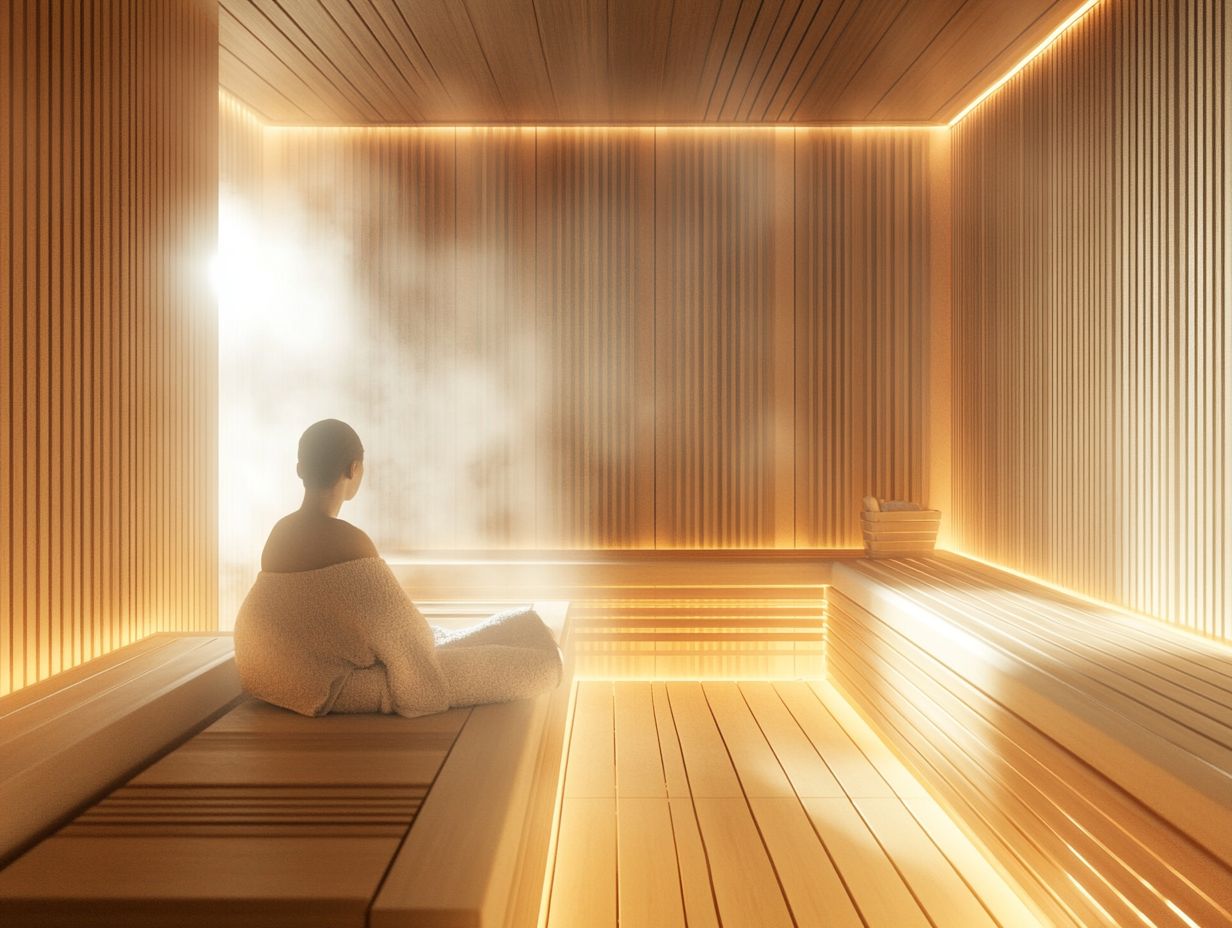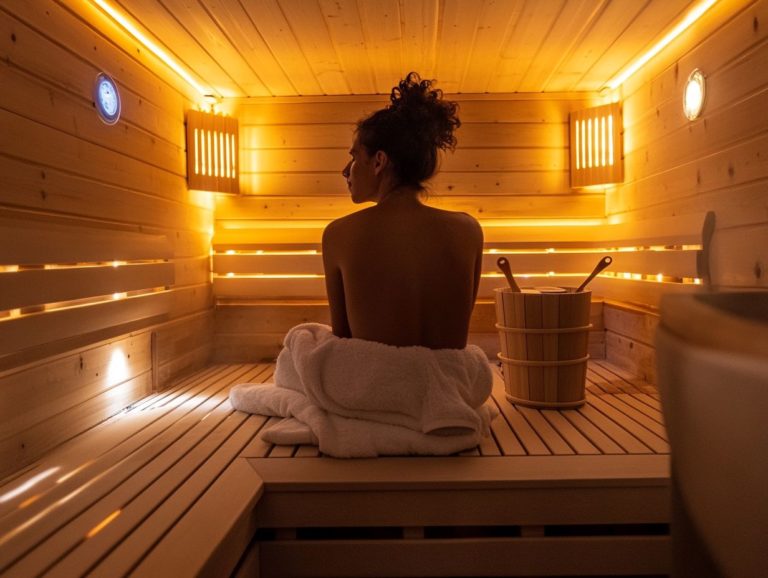The Influence of Sauna Safety on Wellness
Using a sauna is more than just relaxation; it has the potential to significantly elevate both your physical and mental well-being.
With benefits ranging from better blood flow to great stress relief, the advantages are hard to ignore. It’s important to understand sauna safety to fully enjoy these rewards while minimizing any risks.
This guide covers the essentials of sauna use, including the different types available, preparation tips, etiquette, and after-care practices that ensure your experience is both safe and enjoyable. Understanding the differences between traditional saunas and infrared saunas is also key to enhancing your wellness journey.
Get ready to enjoy the warmth and health benefits that saunas can offer! So, let’s dive into how you can enjoy your sauna safely!
Contents
- Key Takeaways:
- The Benefits of Sauna Use
- Understanding Sauna Safety
- Choosing the Right Sauna
- Preparing for a Sauna Session
- Sauna Etiquette and Safety Tips
- After-Sauna Care
- Frequently Asked Questions
- 1. What is the influence of sauna safety on wellness?
- 2. How does sauna safety impact physical wellness?
- 3. Can sauna safety improve mental wellness?
- 4. What are some important safety measures to keep in mind when using a sauna?
- 5. How can sauna safety contribute to emotional wellness?
- 6. Is it important to consider sauna safety when using a public sauna?
Key Takeaways:

- Regular sauna use boosts heart health and lowers blood pressure.
- Choose between traditional and infrared saunas, and prioritize safety features.
- Stay hydrated before and after your sauna session.
The Benefits of Sauna Use
Using a sauna, a cherished tradition in Finnish culture, unlocks a wealth of health benefits that enhance both your physical and mental well-being. Regularly immersing yourself in the soothing warmth of a sauna can improve your cardiovascular health by lowering blood pressure and boosting heart function.
Moreover, it effectively reduces stress and tension. Research indicates that consistent sauna sessions can even elevate cognitive function and enhance exercise tolerance. This makes it a valuable practice for individuals of all ages, especially as they gracefully navigate the complexities of aging.
Physical and Mental Health Benefits
By indulging in this simple yet effective activity, you can experience improved cardiovascular health. Studies from esteemed institutions like Harvard Health reveal that frequent sauna use can enhance your heart function and reduce blood pressure.
The soothing warmth promotes relaxation, helping you alleviate stress and anxiety, ultimately contributing to your mental well-being. Research from the American College of Cardiology suggests that regular use can also provide relief from pain in muscles and joints, making sauna sessions a valuable addition to your routine, especially if you deal with chronic pain or joint discomfort.
These multidimensional benefits position sauna sessions as an approach to enhancing your overall health.
Understanding Sauna Safety
Understanding sauna safety is essential if you want to maximize the health benefits while minimizing any potential risks of sauna bathing. Overexposing yourself to high temperatures can lead to dehydration, so it’s wise to be cautious.
If you have specific health conditions, such as hypertension or cardiovascular disease, consulting a healthcare professional before stepping into a sauna is highly recommended. Conditions like aortic valve stenosis (a condition affecting heart function) or angina pectoris can increase risks, making it crucial to follow safety precautions for a truly positive and enjoyable experience.
Potential Risks and Precautions
While sauna use can offer various benefits, it’s vital to recognize the potential risks, such as dehydration and respiratory issues. Taking the necessary precautions ensures a safe experience.
One main concern during sauna sessions is dehydration. It can lead to dizziness, headaches, and even fainting if you don t maintain proper hydration. If you have pre-existing pulmonary or chronic conditions, be cautious as high temperatures can worsen respiratory issues and affect cardiovascular health.
To mitigate these risks, limit your time in the sauna to 15-20 minutes per session. Make sure to hydrate adequately before and after your use. For a deeper understanding of sauna practices, consider reading about sauna safety and community awareness. If you have any health conditions, consult a healthcare professional before incorporating sauna therapy into your wellness routine.
Choosing the Right Sauna

Choosing the right sauna can greatly improve your experience. Whether you prefer traditional Finnish saunas or contemporary infrared saunas (using light technology), each type has unique advantages tailored to your specific health goals.
Familiarizing yourself with the safety features and technology inherent in each sauna type is essential for making a well-informed decision. This includes understanding the differences between infrared and traditional saunas.
Types of Saunas and Safety Features to Look For
When selecting a sauna, it’s essential to grasp the different types available, including infrared and traditional options, along with their specific health benefits to maximize health benefits and ensure your safety.
Each type boasts unique characteristics tailored to various preferences and wellness needs. Traditional saunas rely on heated rocks or stoves to warm the air, creating a high-temperature environment that promotes sweating and relaxation.
In contrast, infrared saunas utilize light technology to directly heat your body at lower temperatures. This distinction can significantly influence your comfort levels, as infrared options often allow for longer sessions due to their milder heat.
Safety features, such as the materials used in construction like non-toxic woods in infrared designs, enhance your experience. Ultimately, your personal preferences regarding heat intensity and energy methods will play a crucial role in choosing the right sauna for your wellness journey, especially when considering sauna safety.
Preparing for a Sauna Session
Preparing for a sauna session requires careful consideration to ensure both safety and an enhanced experience. Begin with proper hydration and select suitable clothing.
Staying hydrated is crucial to reduce the risk of dehydration that comes with elevated temperatures. Make it a point to drink water before and after your session. This simple practice can significantly enhance your sauna experience.
Proper Hydration and Clothing
Proper hydration and appropriate clothing are essential before you step into a sauna. They are vital for your comfort and overall experience.
Staying adequately hydrated helps regulate your body temperature amidst the intense heat and replenishes fluids lost through sweating. It’s wise to drink water or an electrolyte-rich beverage beforehand to prepare your body for the heat. After your session, rehydrating is equally important for supporting recovery and preventing dehydration.
Regarding clothing, selecting lightweight, moisture-wicking fabrics enhances your comfort while allowing your skin to breathe.
If you re joining a group sauna session, consider a swimsuit or a towel for modesty. This ensures safety and relaxation blend seamlessly during your rejuvenating experience, making it enjoyable for everyone.
Sauna Etiquette and Safety Tips
Understanding sauna etiquette and safety tips is essential for fostering a comfortable atmosphere and maximizing the numerous health benefits that sauna bathing offers. By being mindful of these guidelines, you can enhance your experience and ensure that you reap the rewards of this rejuvenating practice.
Guidelines for Using a Sauna Safely

To truly savor the many health benefits of sauna bathing, you must follow essential guidelines for safe usage. This is especially important if you have health issues that could worsen with sauna use.
Understanding these key tips can enhance your sauna experience, making it enjoyable and beneficial for your overall health, especially when considering sauna safety and the role of innovation.
- Limit each sauna session to 15-20 minutes if you’re new to this delightful practice. Prolonged exposure can lead to overheating.
- Staying well-hydrated before, during, and after your session is crucial. Drinking water replenishes fluids lost through sweat.
- If you have certain health conditions, like cardiovascular or respiratory issues, talk to your doctor first before adding sauna use to your routine.
By following these practical safety measures and understanding the importance of sauna safety training, you can fully enjoy your sauna experience and maximize its health benefits.
After-Sauna Care
After your sauna session, taking care of yourself is crucial for your recovery and to keep the health benefits you’ve gained. Rehydration is key since your body loses fluids through sweat.
Take time to cool down gradually. This helps return your body to its normal state, allowing you to fully enjoy the rejuvenating effects of your experience.
Rehydration and Cooling Down
Rehydration and cooling down are essential after a sauna session. This ensures your body recovers efficiently and stays healthy, especially if you use the sauna regularly.
After spending time in the heat, your fluids can become depleted. It’s crucial to replenish them by drinking water or electrolyte-rich beverages like sports drinks or coconut water.
It’s also important to cool down gradually. Jumping from extreme heat to a cooler environment can induce shock, which affects your heart rate and comfort.
Allow your body to acclimate slowly. Consider resting in a milder setting before diving back into your normal activities.
Frequently Asked Questions
1. What is the influence of sauna safety on wellness?
Sauna safety plays a big role in promoting overall wellness. By ensuring proper safety measures, individuals can fully enjoy the physical, mental, and emotional benefits of using a sauna.
2. How does sauna safety impact physical wellness?

Sauna safety helps physical wellness by reducing the risk of accidents and injuries. It regulates body temperature and can aid in muscle recovery and pain relief.
3. Can sauna safety improve mental wellness?
Yes, sauna safety positively impacts mental wellness by providing relaxation and stress relief. This can improve mood and mental clarity.
4. What are some important safety measures to keep in mind when using a sauna?
Key safety measures include limiting sauna sessions to a recommended time, staying hydrated, and avoiding alcohol before or during sauna use. Also, maintain proper ventilation and be cautious when entering and exiting the sauna.
5. How can sauna safety contribute to emotional wellness?
Sauna safety contributes to emotional wellness by offering a calming and meditative experience. The heat and steam can help release endorphins, which improve mood and reduce anxiety.
6. Is it important to consider sauna safety when using a public sauna?
Absolutely! When using a public sauna, be aware of safety protocols and communicate any concerns with staff. It’s best to bring your own towel and follow hygiene practices to prevent the spread of germs.
We d love to hear your sauna experiences or tips! Share with our community below!






